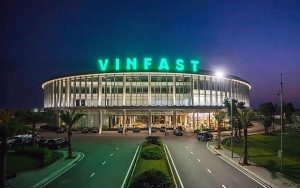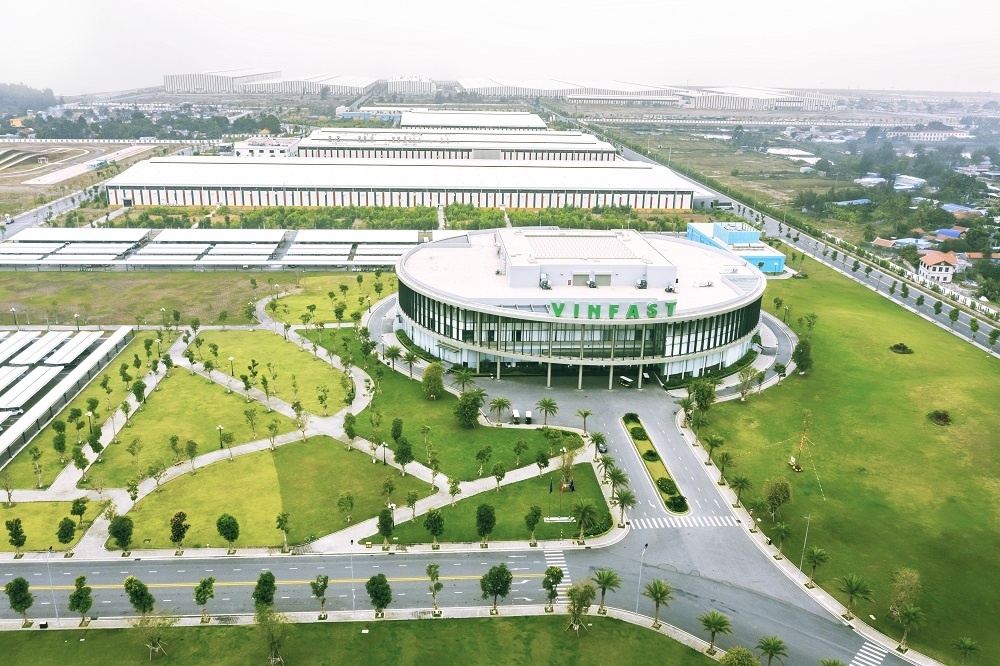Predicting outcome of VinFast IPO plans
What do you think about the structure of VinFast, in terms of the group registering its entity in Singapore?
 |
| Kent Wong, legal committee chairman at the European Chamber of Commerce in Vietnam |
VinFast set up a company in Singapore as part of a holding structure to pivot its proposed listing on the Nasdaq to its domestic company, which has core operations in Vietnam. This is loosely based on the variable interest entity structure which Chinese companies use to achieve a listing in the United States or overseas stock exchanges.
Firstly, it is to establish an offshore company (in this case, Singapore) and then use the offshore company as the main body of future listing or financing. Its shareholding structure will reflect the real situation of the company to be listed. Singapore makes sense due to its proximity to Vietnam and as a well-known financial hub for the region, with free capital and foreign exchange flow, access to global financiers, as well as close and longstanding economic ties with Vietnam.
If domestic companies wish to initial public offering (IPO) and list abroad, they face barriers to list on foreign exchanges.
If VinFast were to endeavour to list directly from a holding company established in Vietnam, there would be a number of regulatory barriers to overcome for such listing, such as foreign ownership restrictions because for some business lines, the foreign ownership ratio is 49 per cent.
Indeed, locally-listed Vietnamese companies are only allowed to list for foreign investors on foreign stock exchanges, while domestic mobilised capital must comply with regulations on the domestic stock exchange.
In addition, they would need to comply with regulations on accounting, auditing and corporate governance standards on foreign exchanges. They would also need to comply with Vietnamese regulations on outbound foreign direct investment.
What are the challenges and opportunities for VinFast’s listing at the moment?
In terms of tough issues, VinFast will not be profitable for at least the next five years. According to the management board, the amount of money Vingroup has to compensate for losses for VinFast has been up to VND18 trillion ($782.6 million) per year. In addition, the cost of operating the company and meeting the criteria to be able to list on the Nasdaq can increase more losses and prolong the time to recover such capital.
Secondly, VinFast will have to resolve an array of legal and business issues (such as organisational structure, financial conditions, accounting standards, and inspection procedures for listing registration documents before listing on the Nasdaq. This will be a huge challenge.
There are some good prospects, however. Going public means the ability of VinFast to mobilise large new capital sources to fund growth, and the selling price of shares will be much higher than in Vietnam. And it will also open opportunities for VinFast to access modern technology, and techniques to serve its development strategy. A cash influx will help lower the company’s debt to income ratio, thereby improving their debt finance terms, and also provides more funds for things like advertising, better compensation packages (thereby attracting top talent), and development of new products.
Furthermore, an IPO is an offer to numerous institutional and retail investors to become shareholders of the company. The multitude of large investors and their confidence in the liquidity of their investment in a publicly listed company assures the current owners of a private company about achieving the maximum possible valuation of the business upon IPO and thereafter.
In addition, partners and contractors of a listed company will feel more confident about its financial state and organisational capabilities compared to a less transparent private business. Partners take additional comfort in the fact that it has gone through rigorous legal, financial, and corporate due diligence, all of which are required for a successful IPO. Confidence among partners and contractors is a sound basis for stable business relations with the listed company, and allows the latter to obtain additional leverage in negotiating better terms for doing business.
Finally, listing provides VinFast with many opportunities for publicity and media coverage. This helps businesses connect, expand international investment, and contribute to improving the prestige of VinFast, which elevates the company’s position to a new level and contributes to realising the strategy of making VinFast a global brand.
VinFast initially intended to file for an IPO at the New York Stock Exchange, but then switched to the Nasdaq. How do you assess the difference between two exchanges?
The Nasdaq is a dealer’s market where buying and selling shares are performed through a dealer who arranges the process. The NYSE is an auction market, where buying and selling is performed through a bidding system where an intermediary oversees the operation. VinFast intends to be in a reseller market with significant human participation, instead of an auction market.
The types of shares traded on the Nasdaq are more volatile, whereas the ones sold in the NYSE are stable and well established. The cost of listing a company there is low compared to the NYSE. Thus, you find more new companies like VinFast to be listed on the Nasdaq.
It is perceived as a high-tech exchange and includes many companies which deal with the internet or electronics. The stocks are considered more growth-oriented. Thus, the Nasdaq is suitable for VinFast. On the other hand, the NYSE is considered to be the exchange for well-established companies that have stable and recognised stocks.
The regulations and requirements to be listed are also different, and the NYSE has much stricter listing conditions. The Nasdaq requires VinFast to provide a convincing plan and execution to prepare the necessary operating capital until the IPO, which will be difficult for VinFast to implement.
According to VinFast’s filing statement, from 2020 to September 2022, the company spent $1.14 billion on research and development (R&D) activities. Is this a large amount for this area?
This shows the recognition of VinFast’s management that R&D is an important driver of economic growth, as it spurs innovation, invention, and progress. While a large amount of R&D spending might be considered capital intensive, it can also lead to breakthroughs that may drive both profits and wellbeing for customers. As a car manufacturer which is tech-heavy, it is essential for R&D in this industry.
Many big car companies in the world have strongly invested in such activities. Tesla spent nearly $2.3 billion in the first nine months of this year, nearly catching up with about $2.6 billion last year. And Toyota in April-September spent up to $4.5 billion on R&D. Previously, from March 2021 to March this year, Toyota spent around $9.2 billion on this activity. In addition, groups that are engaged in R&D can often offset some of these costs and attract investors due to tax breaks and incentives.
North America is VinFast’s major market, but there are plenty of electric vehicle (EV) makers in this region. What are the competitive advantages for VinFast?
VinFast’s competitive edge is its low-cost, tech-heavy EVs. The EV space is indeed a competitive one, VinFast is up against Tesla and other EV makers around the world. However, the company has impressed with its offerings and determination.
While VinFast has cheaper offerings than Tesla and other leading brands, such as Porsche and Mercedes, VinFast has developed different and smart strategies. It launched the plan of renting a battery so that customers can change it easily, which is a competitive strategy to implement because the battery is an important and expensive component of EVs. So far, no company in North America offers renting or exchanging.
Good timing is also a factor. The global fuel crisis has caused petrol prices to rise, making EVs more valuable. Moreover, the chip market crisis is making cars scarce and expensive in the US. At the same time, the current policy of the US government also prioritises environmental protection, including encouraging and funding EV use.
 | VinFast submits IPO in the US VinFast Trading & Investment – a Vingroup subsidiary based in Singapore – has just submitted documents for its first initial public offering (IPO) in the US. |
 | VinFast receives corporate ESG assessment from sustainalytics VinFast, Vietnam's first global electric vehicle manufacturer, has received an indicative Corporate Environmental, Social and Governance (ESG) Assessment from Morningstar Sustainalytics, a globally recognised research, ratings, and data firm. |
What the stars mean:
★ Poor ★ ★ Promising ★★★ Good ★★★★ Very good ★★★★★ Exceptional
Related Contents
Latest News
More News
- Miza Nghi Son green bond marks milestone for sustainable finance (January 19, 2026 | 09:51)
- Higher 2026 growth target puts pressure on credit framework (January 19, 2026 | 09:00)
- VN-Index could reach 2,040 points in 2026 (January 16, 2026 | 16:41)
- Vietnam’s corporate bond market set for a more positive 2026 (January 15, 2026 | 14:10)
- Foreign sentiment towards Vietnam turns more positive (January 15, 2026 | 11:08)
- Wealth management faces skills gap as investor confidence lags (January 13, 2026 | 10:23)
- HDBank completes $100 million international green bond scheme (January 12, 2026 | 16:28)
- Vietnam’s IPO market eyes revival in 2026 (January 09, 2026 | 17:28)
- Brokerage competition tightens as market shares narrow (January 09, 2026 | 15:19)
- Banks set for selective hiring in 2026 (January 08, 2026 | 10:56)

 Tag:
Tag:





















 Mobile Version
Mobile Version